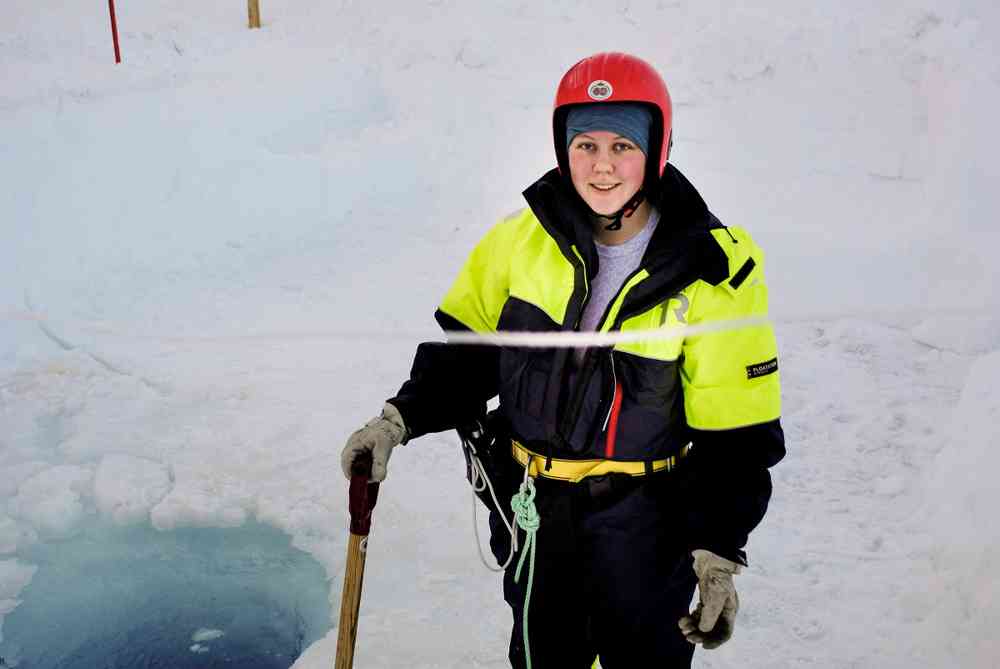The Norwegian young sea ice cruise (N-ICE2015) project was prompted by earlier observations that sea ice in the Fram Strait between Svalbard and Greenland had become thinner.
Its average thickness declined from more than three metres in the early 1990s to less than two metres by 2012. Moreover, first-year ice accounted for a larger share than before.
Since the latter reflects 10 per cent less solar radiation than multi-year ice, more of the sun’s energy is absorbed by ice and sea when the first-year proportion rises.
The cruise report on the Norwegian Polar Institute website.
The expedition was primarily financed by the following Norwegian bodies:
- Ministry of Climate and Environment
- Ministry of Foreign Affairs
- Research Council of Norway
- Norwegian Polar Institute
The following Norwegian institutes participated:
- Norwegian Polar Institute
- University of Tromsø - Arctic University of Norway
- University of Bergen
- University Centre in Svalbard
- Norwegian University of Science and Technology
- Norwegian Meteorological Institute
The following non-Norwegian institutes participated:
- UPMC, France
- AWI, Germany
- University of Hamburg, Germany
- Kopri, South Korea
- ICE-ARC BAS/EU, UK
- BAS, UK
- University of Oxford, UK
- FMI, Finland
- FEI, Finland
- AARI, Russia
- Hokkaido University, Japan
- Cira (ColoState), USA
- Washington State University, USA
- Creel, USA
- Nasa – Ice Bridge, USA
- University of Manitoba, Canada
- DMI, Denmark
- University of Århus, Denmark
- Polish Academy of Sciences, Poland
Journal of Geophysical Research website.
The purpose of the research expedition was to investigate and understand the effects of this thinning in first-year ice for the Arctic.
Observations
Data and observations in such fields as oceanography, marine ecosystems, meteorology and ice dynamics were collected during the cruise.
RV Lance became deliberately frozen into the pack ice north of Svalbard on 12 January last year, and drifted with it through the Fram Strait.
“We encountered more extremes than we’d expected,” says Harald Steen, head of the centre for ice, climate and ecosystems (ICE) at the Norwegian Polar Institute and expedition leader.
“There was more snow and both colder and warmer weather than foreseen. While that doesn’t mean we faced extreme conditions, it shows that existing weather and climate models for the Arctic aren’t good enough. They can’t predict the variations we found.”
The expedition saw that algae bloomed about a month later than expected in the spring, which Steen thinks was probably due to heavier snowfall than predicted.
Water variations
The oceanographers who took part wanted to investigate variations in the water column north of Svalbard, including how close the warm Atlantic water flowing from the south was to the surface.
A related question they were also interested in following up was how much of this warmth mixed vertically in the sea towards the sea ice.
“We had few earlier measurements, particularly from the winter,” explains Lars Henrik Smedsrud, professor of Polar oceanography at the geophysical institute of the University of Bergen (UiB).
His university was one of the research institutes which took part in the expedition, and he was personally on board RV Lance during April and May.
“We got a lot of new information, so the cruise was a success,” he says. “The Atlantic water is warmer than ever. We saw a number of episodes where the warm water was pretty close to the surface, giving a high energy flux up to the ice.”
The UiB oceanographers returned with unique measurements which give them greater insight into processes which determine the thickness and extent of the sea ice.
They are now working on a number of papers describing conditions in the Nansen Basin north-east of Svalbard.
The first scientific results were presented during the Ocean Sciences Meeting in the US city of New Orleans on 21-26 February 2016.
Sampling plankton
Two species of planktonic copepods – Calanus hyperboreus and Calanus finmarchicus – were collected on the cruise by PhD student Maja Hatlebakk of the University Centre in Svalbard (Unis).
The Norwegian Polar Institute primarily has the job of analysing the samples of C hyperboreus, which is endemic in the Arctic and lives largely in deep water.
Responsibility for studying the C finmarchicus samples rests chiefly with Unis. This tiny crustacean is primarily an Atlantic species carried into the Arctic by ocean currents.
“The voyage provided a unique opportunity to take regular samples of zooplankton from areas far to the north and in deep water, which are difficult to access,” says Hatlebakk.
Part of her PhD thesis involves following and comparing C finmarchicus populations. During the winter, zooplankton in the Svalbard fjords enter a form of hibernation, and Hatlebakk’s aim is to study the same processes in the deep ocean.

“We’re still taking samples of plankton around Svalbard, and will start our analyses this summer,” reports PhD student Maja Hatlebakk at the University Centre in Svalbard (Unis). She was on RV Lance as it drifted with the pack ice in the winter and spring of 2015. Photo: Marthe Sandbu.
This will help her to see whether they are hibernating or starting to revive, and under what ambient conditions such developments take place.
“The timing of important stages in the life cycle and such environmental changes as sunlight, food supply and temperature will be observed,” she explains.
“We hope that’ll allow us to say something about the way climate change could affect the Arctic ecosystem.”
Posted
Scientists from all the institutes involved with RV Lance are now working on papers to present their findings. Data and observations acquired during the cruise will be posted to the Norwegian Polar Institute website.
“The Journal of Geophysical Research will also devote a special issue to the findings made during the cruise,” reports Steen.
